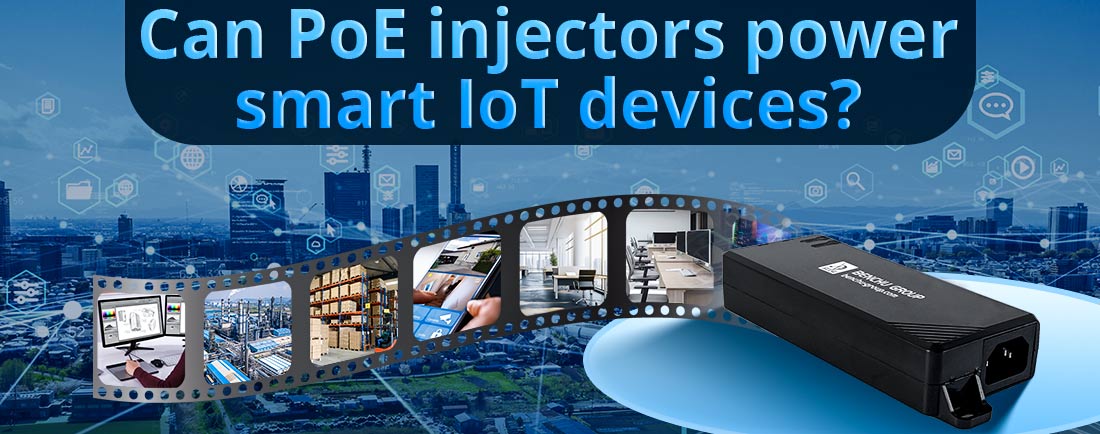
نعم، يمكن لحاقن الطاقة عبر إيثرنت (PoE) تشغيل أجهزة إنترنت الأشياء الذكية المتوافقة مع معايير PoE. تتيح تقنية PoE نقل الطاقة والبيانات من خلال كابل Ethernet واحد، مما يجعلها حلاً عمليًا وفعالاً لتشغيل مجموعة واسعة من أجهزة إنترنت الأشياء (IoT). فيما يلي وصف تفصيلي لكيفية عمل حاقنات PoE مع أجهزة إنترنت الأشياء الذكية وفوائدها.
1. أنواع أجهزة إنترنت الأشياء الذكية التي تعمل عن طريق حاقن PoE
يمكن تشغيل مجموعة متنوعة من أجهزة إنترنت الأشياء في كل من التطبيقات الاستهلاكية والصناعية باستخدام حاقنات بو، مشتمل:
أ. الأجهزة المنزلية الذكية
--- الكاميرات الذكية وأجراس الأبواب: كاميرات أمنية عالية الدقة وأجراس أبواب بالفيديو تستخدم للمراقبة والاتصالات.
--- منظمات الحرارة الذكية: الأجهزة التي تنظم أنظمة التدفئة والتبريد.
--- المراكز الذكية ووحدات التحكم: أنظمة مركزية تتحكم في أجهزة إنترنت الأشياء مثل الأضواء والأقفال والأجهزة.
ب. أجهزة إنترنت الأشياء الصناعية
--- أجهزة الاستشعار البيئية: الأجهزة التي تراقب درجة الحرارة أو الرطوبة أو جودة الهواء.
--- الكاميرات الصناعية: كاميرات مراقبة عالية الطاقة، بما في ذلك نماذج التكبير والإمالة (PTZ).
--- الأجهزة المتصلة في المصانع: أجهزة الاستشعار وأجهزة التحكم في الأتمتة الصناعية.
ج. الأجهزة المعتمدة على الشبكة
--- نقاط الوصول اللاسلكية (WAPs): أجهزة إنترنت الأشياء التي توفر اتصال Wi-Fi بالشبكات الذكية.
--- هواتف VoIP: هواتف متصلة بالإنترنت للاتصال.
--- بوابات إنترنت الأشياء: الأجهزة التي تقوم بجمع البيانات ونقلها بين أجهزة إنترنت الأشياء والخوادم السحابية.
2. كيف تعمل حاقنات PoE مع أجهزة إنترنت الأشياء الذكية
أ. الطاقة والبيانات عبر كابل واحد
--- توفر حاقنات PoE الطاقة والبيانات من خلال كابل إيثرنت واحد، مما يلغي الحاجة إلى مصادر طاقة منفصلة وتبسيط عمليات التثبيت.
ب. الطاقة لمسافات طويلة
--- تدعم تقنية PoE أطوال الكابلات التي تصل إلى 100 متر (328 قدمًا)، مما يجعلها مثالية لتوصيل أجهزة إنترنت الأشياء عن بعد مثل الكاميرات الخارجية أو أجهزة الاستشعار البيئية.
ج. الامتثال للمعايير
عادةً ما تلتزم أجهزة إنترنت الأشياء التي يتم تشغيلها بواسطة حاقنات PoE بمعايير PoE:
--- IEEE 802.3af (PoE): يوفر ما يصل إلى 15.4 وات، وهو مناسب لأجهزة إنترنت الأشياء منخفضة الطاقة مثل الكاميرات وأجهزة الاستشعار القياسية.
--- IEEE 802.3at (PoE+): يوفر ما يصل إلى 25.5 وات، وهو مثالي لأجهزة إنترنت الأشياء متوسطة الطاقة مثل نقاط الوصول والكاميرات المتقدمة.
--- معهد مهندسي الكهرباء والإلكترونيات 802.3bt (بو++): يوفر ما يصل إلى 60 وات أو 100 وات، وهو قادر على تشغيل أجهزة إنترنت الأشياء عالية الطاقة مثل كاميرات PTZ أو المحاور الذكية المتقدمة.
3. فوائد استخدام حاقن PoE لأجهزة إنترنت الأشياء
أ. تركيب مبسط
--- كابل واحد للطاقة والبيانات: يقلل الحاجة إلى كابلات ومنافذ طاقة متعددة.
--- وضع مرن: يمكن تركيب الأجهزة في المواقع المثالية دون التقيد بتوفر مصادر الطاقة القريبة.
ب. فعالية التكلفة
--- تكاليف تركيب أقل: يلغي PoE الحاجة إلى الأسلاك الكهربائية باهظة الثمن.
--- كفاءة الطاقة: توفر حاقنات PoE الطاقة المطلوبة فقط، مما يقلل من استهلاك الطاقة.
ج. موثوقية محسنة
--- مصدر طاقة ثابت: تضمن حاقنات PoE مصدر طاقة ثابتًا لأجهزة IoT.
--- تكامل UPS: عند الاتصال بمصدر طاقة غير منقطع (UPS)، يمكن لحاقن PoE أن تبقي أجهزة إنترنت الأشياء قيد التشغيل أثناء انقطاع التيار الكهربائي.
د. قابلية التوسع
--- يمكن دمج أجهزة إنترنت الأشياء الإضافية بسهولة في الشبكة دون إجراء تغييرات كبيرة على البنية التحتية للطاقة.
ه. السلامة والحماية
--- تشتمل حاقنات PoE على ميزات أمان مثل الحماية من الجهد الزائد ومنع حدوث ماس كهربائي والحماية الحرارية لحماية أجهزة إنترنت الأشياء.
4. اعتبارات عند استخدام حاقنات PoE لأجهزة إنترنت الأشياء
أ. توافق الجهاز
--- تأكد من أن جهاز IoT يدعم معايير PoE.
--- تحقق من متطلبات طاقة الجهاز واختر حاقن PoE الذي يلبي هذه المتطلبات أو يتجاوزها.
ب. ميزانية الطاقة
--- احسب إجمالي استهلاك الطاقة لأجهزة إنترنت الأشياء المتصلة للتأكد من أن خرج طاقة الحاقن كافٍ.
ج. جودة الكابل
--- استخدم كابلات Cat5e أو Cat6 Ethernet عالية الجودة لتقليل فقدان الطاقة والحفاظ على سلامة البيانات.
د. الظروف البيئية
--- بالنسبة لأجهزة إنترنت الأشياء الخارجية أو الصناعية، استخدم حاقنات PoE المقاومة للعوامل الجوية وكابلات Ethernet المتينة.
ه. التدقيق في المستقبل
--- اختر حاقنات PoE التي تدعم المعايير المتقدمة مثل 802.3bt (PoE++) لاستيعاب أجهزة إنترنت الأشياء عالية الطاقة والتوسعات المستقبلية.
5. أمثلة لحالات الاستخدام
أ. أتمتة المنزل الذكي
--- يمكن لحاقن PoE تشغيل شبكة من الكاميرات الذكية وأجراس الأبواب والمحاور لتوفير اتصال سلس وأتمتة في إعداد المنزل.
ب. حلول المكاتب الذكية
--- يمكن تشغيل الأجهزة مثل هواتف VoIP ووحدات التحكم في الإضاءة الذكية ونقاط الوصول مركزيًا وإدارتها باستخدام محاقن PoE.
ج. عمليات نشر إنترنت الأشياء الصناعية
--- يمكن تشغيل أجهزة الاستشعار ووحدات التحكم والكاميرات الصناعية في المصانع أو المستودعات باستخدام محاقن PoE القوية لضمان التشغيل المستمر.
د. شبكات إنترنت الأشياء الخارجية
--- تتيح الحاقنات المقاومة للعوامل الجوية نشر الأجهزة الخارجية مثل كاميرات المراقبة وأجهزة الاستشعار البيئية في المواقع النائية.
6. المزايا التي تتفوق بها على حلول الطاقة التقليدية
| ميزة | حاقن بو | إمدادات الطاقة التقليدية |
| تثبيت | كابل واحد للطاقة والبيانات | يتطلب كابلات طاقة وبيانات منفصلة |
| المرونة | توصيل الطاقة لمسافات طويلة | محدودة بتوافر منفذ الطاقة |
| قابلية التوسع | يدعم بسهولة الأجهزة الجديدة | يتطلب أسلاك طاقة إضافية |
| فعالية التكلفة | انخفاض تكلفة التثبيت الإجمالية | أعلى بسبب الأعمال الكهربائية |
7. الاستنتاج
تعد حاقنات PoE حلاً ممتازًا لتشغيل أجهزة إنترنت الأشياء الذكية، مما يوفر البساطة والمرونة والفعالية من حيث التكلفة. إنها تتيح نشر مجموعة واسعة من أجهزة إنترنت الأشياء، بدءًا من الكاميرات وأجهزة الاستشعار الذكية وحتى نقاط الوصول والبوابات المتقدمة، دون الحاجة إلى كابلات موسعة أو بنية تحتية كهربائية. من خلال ضمان التوافق مع متطلبات الطاقة لأجهزة إنترنت الأشياء واختيار معيار PoE المناسب، توفر حاقنات PoE طريقة موثوقة وقابلة للتطوير ومقاومة للمستقبل لتشغيل إنترنت الأشياء في المنازل الذكية والمكاتب والبيئات الصناعية.